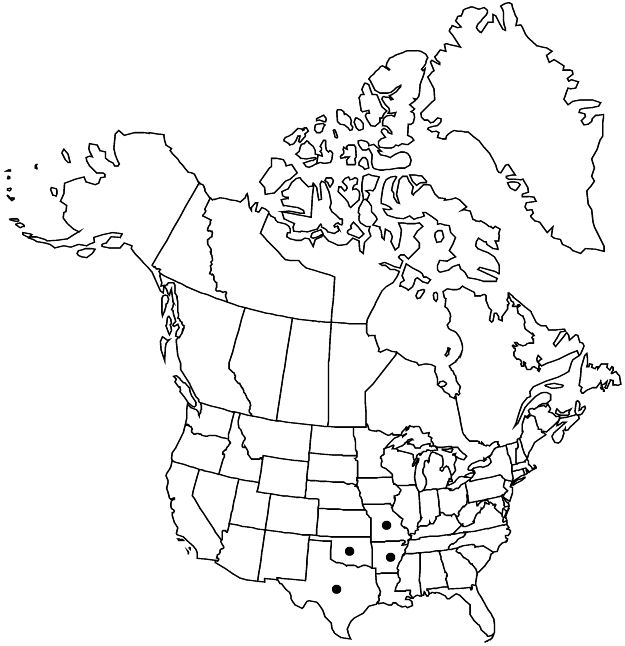Difference between revisions of "Crataegus texana"
Proc. Acad. Nat. Sci. Philadelphia 13: 454. 1862.
FNA>Volume Importer |
RevisionBot (talk | contribs) m (Bot: Adding category Revised Since Print) |
||
| (3 intermediate revisions by 2 users not shown) | |||
| Line 28: | Line 28: | ||
-->{{Treatment/Body | -->{{Treatment/Body | ||
| − | |distribution= | + | |distribution=Ark.;Mo.;Okla.;Tex. |
|discussion=<p>Varieties 2 (2 in the flora).</p><!-- | |discussion=<p>Varieties 2 (2 in the flora).</p><!-- | ||
--><p><i>Crataegus texana</i> is distributed through much of the eastern half of Texas and into Oklahoma, Arkansas, and southwestern Missouri.</p><!-- | --><p><i>Crataegus texana</i> is distributed through much of the eastern half of Texas and into Oklahoma, Arkansas, and southwestern Missouri.</p><!-- | ||
| Line 60: | Line 60: | ||
|basionyms= | |basionyms= | ||
|family=Rosaceae | |family=Rosaceae | ||
| − | |distribution= | + | |distribution=Ark.;Mo.;Okla.;Tex. |
|reference=None | |reference=None | ||
|publication title=Proc. Acad. Nat. Sci. Philadelphia | |publication title=Proc. Acad. Nat. Sci. Philadelphia | ||
|publication year=1862 | |publication year=1862 | ||
|special status=Endemic | |special status=Endemic | ||
| − | |source xml=https:// | + | |source xml=https://bitbucket.org/aafc-mbb/fna-data-curation/src/2e0870ddd59836b60bcf96646a41e87ea5a5943a/coarse_grained_fna_xml/V9/V9_938.xml |
|subfamily=Rosaceae subfam. Amygdaloideae | |subfamily=Rosaceae subfam. Amygdaloideae | ||
|tribe=Rosaceae tribe Gillenieae | |tribe=Rosaceae tribe Gillenieae | ||
| Line 74: | Line 74: | ||
}}<!-- | }}<!-- | ||
| − | -->[[Category:Treatment]][[Category:Crataegus (sect. Coccineae) ser. Molles]] | + | --> |
| + | |||
| + | [[Category:Treatment]] | ||
| + | [[Category:Crataegus (sect. Coccineae) ser. Molles]] | ||
| + | [[Category:Revised Since Print]] | ||
Latest revision as of 18:08, 6 November 2020
Shrubs or trees, 100 dm. Stems: older trunk bark nearly black, grooved, younger gray, fibrous, checked into longitudinal plates; twigs: new growth lanate, 1-year old pale grayish tan, older gray; thorns on twigs absent or frequent, straight, 2-years old ± bright chestnut brown or shiny black, fine, 4–5 cm. Leaves: petiole length 37–43% blade, tomentose young, glabrescent, eglandular; blade broadly elliptic, narrowly rhombic, rhombic, rhombic-ovate, or broadly ovate, 4–7 cm, thin, base broadly cuneate to rounded, lobes 1–4 per side, sinuses shallow to deep, lobe apex obtuse to subacute, margins strongly serrate except proximally, teeth 2–3 mm, veins 5 per side, apex acute to subacute or obtuse, abaxial surface sparsely to densely white-tomentose young, less dense mature, veins densely hairy, adaxial densely scabrous young, glabrescent. Inflorescences 7–12-flowered; branches tomentose, sometimes glabrescent; bracteoles caducous, ± linear, (larger) herbaceous to (smaller) membranous, margins glandular. Flowers 14–22 mm diam.; hypanthium tomentose; sepals narrowly triangular, 4–6 mm, margins glandular-serrate to glandular-laciniate, abaxially densely pubescent; stamens 20, anthers rose, rose-purple, red, or purple; styles 4 or 5. Pomes red, sometimes red-orange, suborbicular, 9–14(–25) mm diam., with remnant tomentum; sepals often eroded or broken, spreading; pyrenes 4 or 5.
Distribution

Ark., Mo., Okla., Tex.
Discussion
Varieties 2 (2 in the flora).
Crataegus texana is distributed through much of the eastern half of Texas and into Oklahoma, Arkansas, and southwestern Missouri.
Crataegus texana is provisionally treated as a complex of pink- to purple-anthered, 20-stamened, red-fruited forms.
Selected References
None.
Key
| 1 | Leaf blades: lobes 2–4 per side, sinuses deep, lobe apices ± angled. | Crataegus texana var. texana |
| 1 | Leaf blades: lobes 1 or 2(or 3) per side, sinuses shallow, lobe apices ± obtuse to subacute. | Crataegus texana var. dasyphylla |